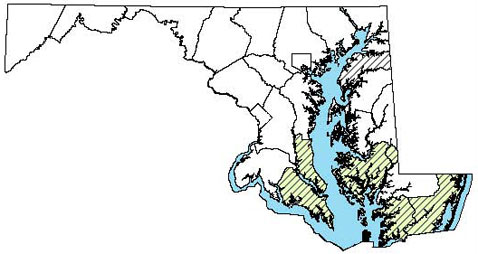Field Guide to Maryland's Frogs and Toads (Order Anura)
Main_Content
Eastern Narrow-mouthed Toad (Gastrophryne carolinensis) | Photo by: John White | | Former Name: |
Size:
- ⅞ - 1¼ inches
- Record - 1½ inches
|
Appearance:- Shape is unlike any other toad or frog.
- A rotund body, narrow and sharp-pointed head and very small mouth.
- It has the chameleon-like ability to change color fairly rapidly, but body coloration is usually varying shades of gray, brown, or reddish.
- It typically has a lighter colored blotch or line separating the darker back from the grayer sides.
- Its skin has a granular knobby appearance.
|
Habitats:- Uses many habitats, but must be moist and provide shelter.
- Typically found in areas of sandy, loose soil.
- Found at margins of bodies of water and in small seasonally wet depressions, usually under debris.

Photo of Eastern Narrow-mouthed Toad Habitat
courtesy of Rebecca Chalmers
|
How to Find:- Listen for its explosive buzzy call “baaaaaa”, that has been likened to the “bleat of a sheep”.
- An explosive breeder that calls at night during and immediately following “gully washers” from May to early July, it may call only a few nights per year at any one site.
- Look under debris (even human garbage) next to potential breeding ponds.
|
Distribution in Maryland:Found only in a handful of coastal plain counties. This species is listed as state Endangered. If found, please report sightings to the Maryland Wildlife and Heritage Service.  | | For More Information: |
|
